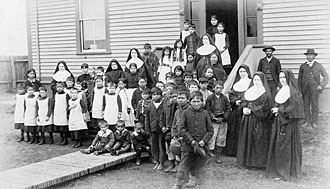| Home > Art and Photography > Framing Canada | Français | |

Aboriginal Peoples Indian residential school students and nuns Photography has been an active participant in the complicated relationship between the dominant Canadian culture and Aboriginal peoples. Photography's dual role, as both documentary instrument and art form, has led to the creation and perpetuation of some of the most lasting stereotypes. It is hoped that through contemporary eyes, these images will be questioned and perhaps recontextualized. Photographers have sought opportunities to document the world's people and geography since the birth of photographic technology. Armed with the task of recording, photographers were along for the journey as Canada's geography was explored -- whether by sea, as with some of the earliest images of Atlantic Canada and the Mi'kmaq people taken by French officer Paul-Émile Miot; or by land, such as the expedition photographs of the Assiniboine and Saskatchewan by Humphrey Lloyd Hime. In tandem with the ethnographic applications of their medium, photographers were aware of its aesthetic powers in creating a record of those people they believed to be part of a "vanishing race." American photographer Edward S. Curtis created one of the largest initiatives of this type, the series entitled The North American Indian. Consisting of over 20 volumes of photogravures and accompanying text, the project contains portraits of individuals as well as views of daily life, taken in Aboriginal communities west of the Mississippi, on the Canadian west coast and in Arctic and sub-Arctic regions. One of the darkest periods in Canada's relationship with Aboriginal peoples occurred when thousands of Aboriginal children were taken from their families and made to attend residential schools as part of a government initiative of forced assimilation into mainstream culture. The profound effects of this tragedy continue to the present day. The photographs of children in front of rural schoolhouses or posed in "before" and "after" portraits (showing their transformation from traditional clothing and hairstyles to Euro-Canadian attire) are some of the most tragic images in Library and Archives Canada's collection. While it is clear that this period in the history of photography attests to some of the darkest moments for Aboriginal peoples, it likewise commemorates individuals and occasions worthy of celebration and pride. Among many others, the collection contains portraits of Gabriel Dumont and Louis Riel, Métis leaders of the Northwest Rebellion of 1885; Pauline Johnson, recognized as one of the first Aboriginal poets in Canada; and Tom Longboat, one of Canada's greatest athletes. |